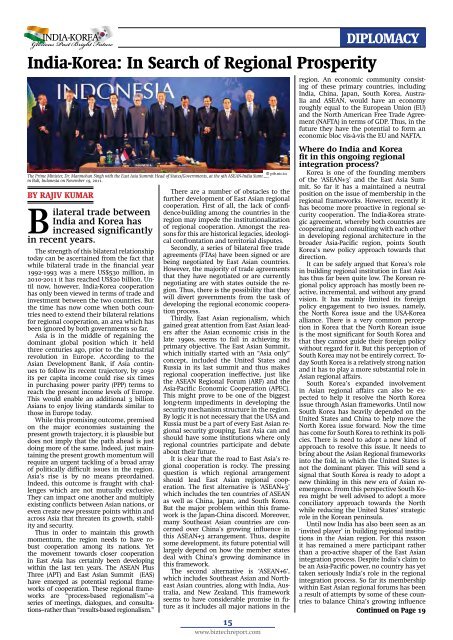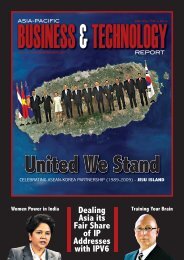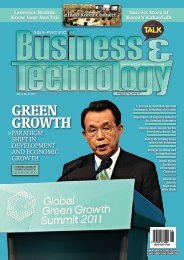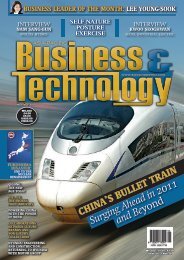INDIA-KOREA - Asia-Pacific Business and Technology Report
INDIA-KOREA - Asia-Pacific Business and Technology Report
INDIA-KOREA - Asia-Pacific Business and Technology Report
You also want an ePaper? Increase the reach of your titles
YUMPU automatically turns print PDFs into web optimized ePapers that Google loves.
<strong>INDIA</strong>-<strong>KOREA</strong><br />
Glorious Past Bright Future<br />
India-Korea: In Search of Regional Prosperity<br />
© pib.nic.in<br />
The Prime Minister, Dr. Manmohan Singh with the East <strong>Asia</strong> Summit Head of States/Governments, at the 9th ASEAN-India Summit,<br />
in Bali, Indonesia on November 19, 2011.<br />
by Rajiv Kumar<br />
Bilateral trade between<br />
India <strong>and</strong> Korea has<br />
increased significantly<br />
in recent years.<br />
The strength of this bilateral relationship<br />
today can be ascertained from the fact that<br />
while bilateral trade in the financial year<br />
1992-1993 was a mere US$530 million, in<br />
2010-2011 it has reached US$20 billion. Until<br />
now, however, India-Korea cooperation<br />
has only been viewed in terms of trade <strong>and</strong><br />
investment between the two countries. But<br />
the time has now come when both countries<br />
need to extend their bilateral relations<br />
for regional cooperation, an area which has<br />
been ignored by both governments so far.<br />
<strong>Asia</strong> is in the middle of regaining the<br />
dominant global position which it held<br />
three centuries ago, prior to the industrial<br />
revolution in Europe. According to the<br />
<strong>Asia</strong>n Development Bank, if <strong>Asia</strong> continues<br />
to follow its recent trajectory, by 2050<br />
its per capita income could rise six times<br />
in purchasing power parity (PPP) terms to<br />
reach the present income levels of Europe.<br />
This would enable an additional 3 billion<br />
<strong>Asia</strong>ns to enjoy living st<strong>and</strong>ards similar to<br />
those in Europe today.<br />
While this promising outcome, premised<br />
on the major economies sustaining the<br />
present growth trajectory, it is plausible but<br />
does not imply that the path ahead is just<br />
doing more of the same. Indeed, just maintaining<br />
the present growth momentum will<br />
require an urgent tackling of a broad array<br />
of politically difficult issues in the region.<br />
<strong>Asia</strong>’s rise is by no means preordained.<br />
Indeed, this outcome is fraught with challenges<br />
which are not mutually exclusive.<br />
They can impact one another <strong>and</strong> multiply<br />
existing conflicts between <strong>Asia</strong>n nations, or<br />
even create new pressure points within <strong>and</strong><br />
across <strong>Asia</strong> that threaten its growth, stability<br />
<strong>and</strong> security.<br />
Thus in order to maintain this growth<br />
momentum, the region needs to have robust<br />
cooperation among its nations. Yet<br />
the movement towards closer cooperation<br />
in East <strong>Asia</strong> has certainly been developing<br />
within the last ten years. The ASEAN Plus<br />
Three (APT) <strong>and</strong> East <strong>Asia</strong>n Summit (EAS)<br />
have emerged as potential regional frameworks<br />
of cooperation. These regional frameworks<br />
are “process-based regionalism”–a<br />
series of meetings, dialogues, <strong>and</strong> consultations–rather<br />
than “results-based regionalism.”<br />
There are a number of obstacles to the<br />
further development of East <strong>Asia</strong>n regional<br />
cooperation. First of all, the lack of confidence-building<br />
among the countries in the<br />
region may impede the institutionalization<br />
of regional cooperation. Amongst the reasons<br />
for this are historical legacies, ideological<br />
confrontation <strong>and</strong> territorial disputes.<br />
Secondly, a series of bilateral free trade<br />
agreements (FTAs) have been signed or are<br />
being negotiated by East <strong>Asia</strong>n countries.<br />
However, the majority of trade agreements<br />
that they have negotiated or are currently<br />
negotiating are with states outside the region.<br />
Thus, there is the possibility that they<br />
will divert governments from the task of<br />
developing the regional economic cooperation<br />
process.<br />
Thirdly, East <strong>Asia</strong>n regionalism, which<br />
gained great attention from East <strong>Asia</strong>n leaders<br />
after the <strong>Asia</strong>n economic crisis in the<br />
late 1990s, seems to fail in achieving its<br />
primary objective. The East <strong>Asia</strong>n Summit,<br />
which initially started with an “<strong>Asia</strong> only”<br />
concept, included the United States <strong>and</strong><br />
Russia in its last summit <strong>and</strong> thus makes<br />
regional cooperation ineffective, just like<br />
the ASEAN Regional Forum (ARF) <strong>and</strong> the<br />
<strong>Asia</strong>-<strong>Pacific</strong> Economic Cooperation (APEC).<br />
This might prove to be one of the biggest<br />
long-term impediments in developing the<br />
security mechanism structure in the region.<br />
By logic it is not necessary that the USA <strong>and</strong><br />
Russia must be a part of every East <strong>Asia</strong>n regional<br />
security grouping. East <strong>Asia</strong> can <strong>and</strong><br />
should have some institutions where only<br />
regional countries participate <strong>and</strong> debate<br />
about their future.<br />
It is clear that the road to East <strong>Asia</strong>’s regional<br />
cooperation is rocky. The pressing<br />
question is which regional arrangement<br />
should lead East <strong>Asia</strong>n regional cooperation.<br />
The first alternative is ‘ASEAN+3’<br />
which includes the ten countries of ASEAN<br />
as well as China, Japan, <strong>and</strong> South Korea.<br />
But the major problem within this framework<br />
is the Japan-China discord. Moreover,<br />
many Southeast <strong>Asia</strong>n countries are concerned<br />
over China’s growing influence in<br />
this ASEAN+3 arrangement. Thus, despite<br />
some development, its future potential will<br />
largely depend on how the member states<br />
deal with China’s growing dominance in<br />
this framework.<br />
The second alternative is ‘ASEAN+6’,<br />
which includes Southeast <strong>Asia</strong>n <strong>and</strong> Northeast<br />
<strong>Asia</strong>n countries, along with India, Australia,<br />
<strong>and</strong> New Zeal<strong>and</strong>. This framework<br />
seems to have considerable promise in future<br />
as it includes all major nations in the<br />
15<br />
www.biztechreport.com<br />
DIPLOMACY<br />
region. An economic community consisting<br />
of these primary countries, including<br />
India, China, Japan, South Korea, Australia<br />
<strong>and</strong> ASEAN, would have an economy<br />
roughly equal to the European Union (EU)<br />
<strong>and</strong> the North American Free Trade Agreement<br />
(NAFTA) in terms of GDP. Thus, in the<br />
future they have the potential to form an<br />
economic bloc vis-à-vis the EU <strong>and</strong> NAFTA.<br />
Where do India <strong>and</strong> Korea<br />
fit in this ongoing regional<br />
integration process?<br />
Korea is one of the founding members<br />
of the ‘ASEAN+3’ <strong>and</strong> the East <strong>Asia</strong> Summit.<br />
So far it has a maintained a neutral<br />
position on the issue of membership in the<br />
regional frameworks. However, recently it<br />
has become more proactive in regional security<br />
cooperation. The India-Korea strategic<br />
agreement, whereby both countries are<br />
cooperating <strong>and</strong> consulting with each other<br />
in developing regional architecture in the<br />
broader <strong>Asia</strong>-<strong>Pacific</strong> region, points South<br />
Korea’s new policy approach towards that<br />
direction.<br />
It can be safely argued that Korea’s role<br />
in building regional institution in East <strong>Asia</strong><br />
has thus far been quite low. The Korean regional<br />
policy approach has mostly been reactive,<br />
incremental, <strong>and</strong> without any gr<strong>and</strong><br />
vision. It has mainly limited its foreign<br />
policy engagement to two issues, namely,<br />
the North Korea issue <strong>and</strong> the USA-Korea<br />
alliance. There is a very common perception<br />
in Korea that the North Korean issue<br />
is the most significant for South Korea <strong>and</strong><br />
that they cannot guide their foreign policy<br />
without regard for it. But this perception of<br />
South Korea may not be entirely correct. Today<br />
South Korea is a relatively strong nation<br />
<strong>and</strong> it has to play a more substantial role in<br />
<strong>Asia</strong>n regional affairs.<br />
South Korea’s exp<strong>and</strong>ed involvement<br />
in <strong>Asia</strong>n regional affairs can also be expected<br />
to help it resolve the North Korea<br />
issue through <strong>Asia</strong>n frameworks. Until now<br />
South Korea has heavily depended on the<br />
United States <strong>and</strong> China to help move the<br />
North Korea issue forward. Now the time<br />
has come for South Korea to rethink its policies.<br />
There is need to adopt a new kind of<br />
approach to resolve this issue. It needs to<br />
bring about the <strong>Asia</strong>n Regional frameworks<br />
into the fold, in which the United States is<br />
not the dominant player. This will send a<br />
signal that South Korea is ready to adopt a<br />
new thinking in this new era of <strong>Asia</strong>n reemergence.<br />
From this perspective South Korea<br />
might be well advised to adopt a more<br />
conciliatory approach towards the North<br />
while reducing the United States’ strategic<br />
role in the Korean peninsula.<br />
Until now India has also been seen as an<br />
‘invited player’ in building regional institutions<br />
in the <strong>Asia</strong>n region. For this reason<br />
it has remained a mere participant rather<br />
than a pro-active shaper of the East <strong>Asia</strong>n<br />
integration process. Despite India’s claim to<br />
be an <strong>Asia</strong>-<strong>Pacific</strong> power, no country has yet<br />
taken seriously India’s role in the regional<br />
integration process. So far its membership<br />
within East <strong>Asia</strong>n regional forums has been<br />
a result of attempts by some of these countries<br />
to balance China’s growing influence<br />
Continued on Page 19









